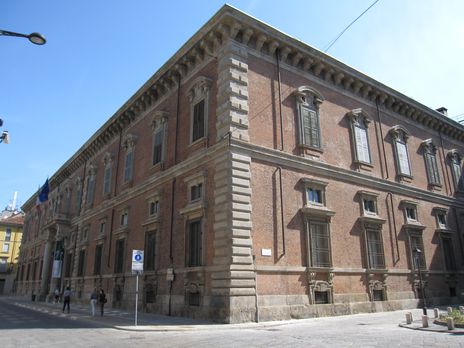

Palazzo di Brera, the most prominent building in the Brera neighborhood, houses six institutions: the Braidense National Library (one of Italy's largest), the Brera Astronomical Observatory, the Brera Botanical Garden, the Lombard Institute of Sciences and Letters, the Brera Art Gallery and the Brera Fine Arts Academy.
It all began in 1571, when Pope Pius V abolished the Order of the Humiliati that operated in the convent that had originally stood on the spot of today's palazzo. The convent was then given to the studious Jesuits Order, which immediately founded a center of study and research on the premises. In 1591 the Jesuits decided to construct a bigger building and thus began a project that lasted for almost two hundred years. The first major architect to work on the structure was Francesco Maria Richini, who halted construction in 1630 due to a devastating plague that swept through the city. Work on the building resumed only towards the end of the 17th century and continued until the end of the following century, when the Jesuits Order had already been dissolved and Milan was an Austrian province. The last architect to have contributed to the building was Giuseppe Piermarini. The palace became known as the Reale Palazzo and in 1776 Empress Maria Theresa of Austria established the Palatine Schools in the premises, along with a library and a botanical garden. She also founded a prestigious art academy that played a vital role in the development of Italian art and that still functions today, attracting students from all over the world. Piermarini was appointed head of the architecture faculty, while poet and scholar Giuseppe Parini became the first dean.
The academy, under the guidance of various directors, began acquiring works of art from every part of the Italian peninsula, offering its students a wide range of masters to learn from. It also began to organize annual exhibitions similar to the Paris salons. By mid 19th century, after the Napoleonic era, when Lombardy had returned to Austrian control and the Italian art that Napoleon had seized was given back to its original owners, Milan became the cultural fulcrum of Italy.
At that time the academy's director was Milan's most famous 19th century painter, Venetian-born Francesco Hayez, who actually had very humblest origins. Hayez was a very diverse and prolific painter. His genres included historical paintings, female nudes - with an emphasis on odalisques, everyday urban scenes and portraits of the elite. The latter made him one of the most sough-after artists of his age among the aristocracy. His style has been characterized as a subtle mixture of Neoclassicism and Romanticism.
In 1859, after Napoleon III's visit to Milan, the Academy acquired a bronze statue of Napoleon I as peacemaker Mars and placed it in the center of the palace's elegant, double-loggia courtyard. The statue had been commissioned by Viceroy of Italy and Napoleon I's stepson, Eugene de Beauharnais. It was executed in Rome in 1812 from a model by celebrated neoclassical Venetian sculptor Antonio Canova.
Today the Brera Academy is one of the most distinguished art schools in the world. Formally it has the status of a university, offering Bachelors and Masters Degrees. It also has the highest percentage of foreign students out of all Italian universities, 24 percent. Currently there are about 4,000 students studying at the academy with more than 850 of them coming from abroad. It has five main faculties - Painting, Sculpture, Interior Design, Fashion Design and Scenic Design, as well as four smaller departments - Restoration, Sacred Art, Art Curating and Multimedia Communication. As can be imagined the admission process is extremely selective.
The Brera Art Gallery, or the Pinacoteca Brera, as it is known in Italian, consists of the art collection that the academy had acquired in the 18th and 19th centuries. It separated from the Brera Academy in 1882 and became an autonomous institution, continuing the acquisition of art works from all part of Europe.
During World War I the gallery's collection was moved to Rome, even though the building was not damaged during the conflict. However, in the Second World War the museum underwent severe damage in the course of the Allied bombing of 1943, which destroyed the vaults in thirty of the thirty-eight rooms. Fortunately, director Fernanda Wittgens had placed the artwork in a safe location and in 1946, thanks to donations from the wealthy Milanese families and institutions, she began restoring the gallery.
Today the Brera Art Gallery is one of the most visited in Italy. In Milan it is the artistic institution par excellence. To have been in Milan and not have seen the gallery is to have missed a significant portion of Italian and North European masterpieces. It houses works from eminent artists such as Andrea Mantegna (The Lamentation of Christ), Bramantino, Raphael (The Marriage of the Virgin), Giovanni Bellini, Donato Bramante, Piero della Francesca (Holy Conversation), Bronzino, Carracci, Tintoretto (Finding of the body of St. Mark), Titian, Rubens, Van Dyck, Correggio, Caravaggio (Supper at Emmaus) and last but not least, Milan's most beloved Francesco Hayez, whose 1859 painting The Kiss epitomizes the Romantic Age.